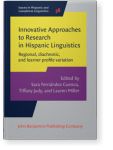Chapter 7
Civics, ideology, and Spanish in Kansas
Implications for heritage Spanish pedagogies
Research on Spanish as a Heritage Language (HL)
describes how integrative ideologies emphasizing
cultural/linguistic identity motivate HL students more than
instrumental ideologies of Spanish as a
professional resource. Less explored are civic
ideologies of serving communities through bilingualism. Studies of
service-learning in language classes highlight the importance of
civics, but do not analyze civic motivations as part of
service-learning’s efficacy. To further ground pedagogical theory in
community norms, I explore ideologies/motivations among heritage
Spanish speakers outside of HL programs. The analysis suggests
participants variably associate civic, instrumental, and integrative
ideologies with their language capabilities, simultaneously
positioning themselves as variably integrated within the community.
These associations ask us to rethink common conceptions of
motivation.
Article outline
- 1.Introduction
- 2.Background
- 2.1Learner motivation and language ideologies
- 2.2Heritage language learner needs and community
service-learning
- 2.3Community norms and heritage language pedagogies
- 3.Methods
- 3.1Data and participants
- 3.2Research questions and hypotheses
- 3.3Analysis procedures
- 4.Results
- 4.1Veronica
- 4.2Kristina
- 4.3Andrés
- 5.Conclusion
-
Note
-
References
